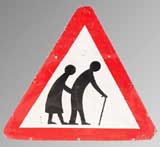



Osteoporosis affects the bones of millions of people worldwide. The disease is characterized by low bone mass and deterioration of bone tissue, which leads to fragile bones and a greater risk of fracture, particularly in older people. Osteoporosis fractures are a significant cause of disability and premature death.
Fracture rates vary between men and women. In countries where fractures are frequent, women are affected three to four times more often than men. In countries were fracture rates are low, men and women are nearly equally affected. In both genders, the risk of vertebral and hip fractures increases with age, while the risk of wrist fractures levels off after the age of 60
Hip fracture rates are highest for Caucasian women living in temperate climates and lowest for women in Africa. The frequency of fractures has generally increased in countries in economic transition while rates in developed countries have levelled off.
Approximately 1.66 million hip fractures occur each year. This number is expected to increase four-fold by 2050 because of the increasing number of older people.
This text is a summary of: WHO/FAO
Diet, Nutrition and the prevention of chronic diseases
Section 5 Population nutrient intake goals for preventing diet-related chronic diseases, 5.7 Recommendations for preventing osteoporosis, 5.7.1 Background – 5.7.2 Trends![]()
Calcium and vitamin D deficiencies increase the risk of osteoporosis in older people. Appropriate supply of certain nutrients, particularly calcium and vitamin D, have been shown to play a role in limiting the risk of osteoporosis in older people. Other nutrients that might be important for bone health include zinc, copper, manganese, boron, vitamin A, vitamin C, vitamin K, B vitamins, and potassium.
Calcium is a mineral that is essential to bone health in all stages of life, although the recommended daily intake is currently a subject of debate.
Vitamin D can be acquired from certain foods or can be produced in the body through the action of sunlight on the skin. Deficiency in Vitamin D can cause the softening of bones, leading to rickets in children and osteomalacia in adults. In older people less severe deficiencies have been linked to loss of bone minerals and osteoporotic fractures.
Evidence shows that sufficient intake of both vitamin D and calcium reduces the risk of osteoporosis in older people. In contrast, low body weight and high alcohol consumption increase the risk of osteoporosis. Fluoride intake does not appear to affect the risk of osteoporosis in older people.
This text is a summary of: WHO/FAO
Diet, Nutrition and the prevention of chronic diseases
Section 5 Population nutrient intake goals for preventing diet-related chronic diseases, 5.7 Recommendations for preventing osteoporosis, 5.7.3 Diet, physical activity and osteoporosis![]()

The risk of osteoporosis in older people may be reduced through a diet providing more calcium and vitamin D. However, such preventive measures should not necessarily be applied to all population groups across the world, but should rather focus on high risk sub-groups of populations. Indeed, calcium requirements vary between geographic regions and cultures because of differing dietary, genetic, and lifestyle factors. Furthermore, the interaction between calcium intake and physical activity, sun exposure, and intake of other dietary components needs to be considered before recommending increased calcium intake in countries with low fracture incidence in order to be in line with recommendations for developed countries.
In countries where fractures are very common, a calcium intake of at least 400-500 mg per day is required to prevent osteoporosis. It is also recommended that in order to obtain sufficient Vitamin D, especially when sunshine is limited, the diet should provide 5-10 mg per day.
Sources of calcium include dairy products, fish with edible bones, tortillas processed with lime, certain green vegetables such as broccoli, legumes, and tofu.
Even though calcium intakes through dairy products are higher in developed countries, hip fractures are more frequent there than in developing countries. This may be explained by the negative effect of animal protein which may outweigh the beneficial effect of calcium intake.
Prudent measures that contribute to preventing other chronic diseases may also be helpful in reducing fracture risk:
This text is a summary of: WHO/FAO
Diet, Nutrition and the prevention of chronic diseases
Section 5 Population nutrient intake goals for preventing diet-related chronic diseases, 5.7 Recommendations for preventing osteoporosis, 5.7.5 Disease-specific recommendations![]()

This summary is free and ad-free, as is all of our content. You can help us remain free and independant as well as to develop new ways to communicate science by becoming a Patron!